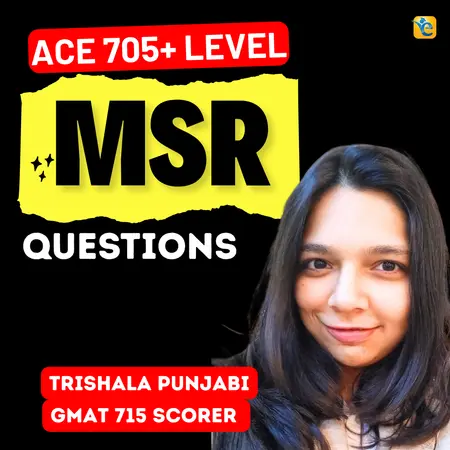Events & Promotions
|
|

GMAT Club Daily Prep
Thank you for using the timer - this advanced tool can estimate your performance and suggest more practice questions. We have subscribed you to Daily Prep Questions via email.
Customized
for You
Track
Your Progress
Practice
Pays
Not interested in getting valuable practice questions and articles delivered to your email? No problem, unsubscribe here.
- Nov 22
11:00 AM IST
-01:00 PM IST
Do RC/MSR passages scare you? e-GMAT is conducting a masterclass to help you learn – Learn effective reading strategies Tackle difficult RC & MSR with confidence Excel in timed test environment - Nov 23
11:00 AM IST
-01:00 PM IST
Attend this free GMAT Algebra Webinar and learn how to master the most challenging Inequalities and Absolute Value problems with ease. - Nov 25
10:00 AM EST
-11:00 AM EST
Prefer video-based learning? The Target Test Prep OnDemand course is a one-of-a-kind video masterclass featuring 400 hours of lecture-style teaching by Scott Woodbury-Stewart, founder of Target Test Prep and one of the most accomplished GMAT instructors.
Kudos
Bookmarks
E
Be sure to select an answer first to save it in the Error Log before revealing the correct answer (OA)!
Difficulty:
 35%
(medium)
35%
(medium)
Question Stats:
77% (02:11) correct 23%
(02:41)
wrong
23%
(02:41)
wrong  based on 3482
sessions
based on 3482
sessions
History
Date
Time
Result
Not Attempted Yet
In a poll, 200 subscribers to Financial Magazine X indicated which of five specific companies they own stock in. The results are shown in the table above. If 15 of the 200 own stock in both IBM and AT&T, how many of those polled own stock in neither company?
(A) 63
(B) 93
(C) 107
(D) 122
(E) 137
PS51950.02
Attachment:
2020-04-20_2303.png [ 39.57 KiB | Viewed 54375 times ]
Originally posted by BrentGMATPrepNow on 29 Apr 2020, 09:01.
Last edited by BrentGMATPrepNow on 18 Feb 2022, 08:32, edited 1 time in total.
Last edited by BrentGMATPrepNow on 18 Feb 2022, 08:32, edited 1 time in total.
Kudos
Bookmarks
gmatt1476
Another approach is to use the Double Matrix Method. This technique can be used for questions featuring a population in which each member has two characteristics associated with it (aka overlapping sets questions).
Here, we have a population of 200 magazine subscribers and the two characteristics we need to focus on are:
- owns stock in IBM or does not own stocks in IBM
- owns stock in AT&T or does not own stocks in AT&T
So we can set up our diagram as follows:

If 30 of the 200 subscribers own stock in AT&T, then the other 170 subscribers do NOT own stock in AT&T
If 48 of the 200 subscribers own stock in IBM, then the other 152 subscribers do NOT own stock in IBM
When we add this to our diagram we get the following:

At this point, we can complete the rest of our diagram:

Since the bottom-right square represents subscribers who own stock in neither company, the correct answer is E
This question type is VERY COMMON on the GMAT, so be sure to master the technique.
Aside: We can also use Venn diagrams and formulae to solve overlapping sets questions. However, as difficulty levels increase, it becomes harder to apply those other approaches, whereas the Double Matrix Method works every time.
To learn more about the Double Matrix Method, watch this video:
EXTRA PRACTICE QUESTION
More questions to practice with:
EASY: https://gmatclub.com/forum/of-the-120-p ... 15386.html
MEDIUM: https://gmatclub.com/forum/in-a-certain ... 21716.html
HARD: https://gmatclub.com/forum/a-group-of-2 ... 24888.html
KILLER: https://gmatclub.com/forum/a-certain-hi ... 32899.html
Kudos
Bookmarks
N(IBM) = 48
N(AT&T) = 30
N(IBM)⋂ N(AT&T) = 15
N(IBM) U N(AT&T) = 48+30 - 15 = 63
Number of those polled own stock in neither company = 200-63 =137
N(AT&T) = 30
N(IBM)⋂ N(AT&T) = 15
N(IBM) U N(AT&T) = 48+30 - 15 = 63
Number of those polled own stock in neither company = 200-63 =137
gmatt1476










